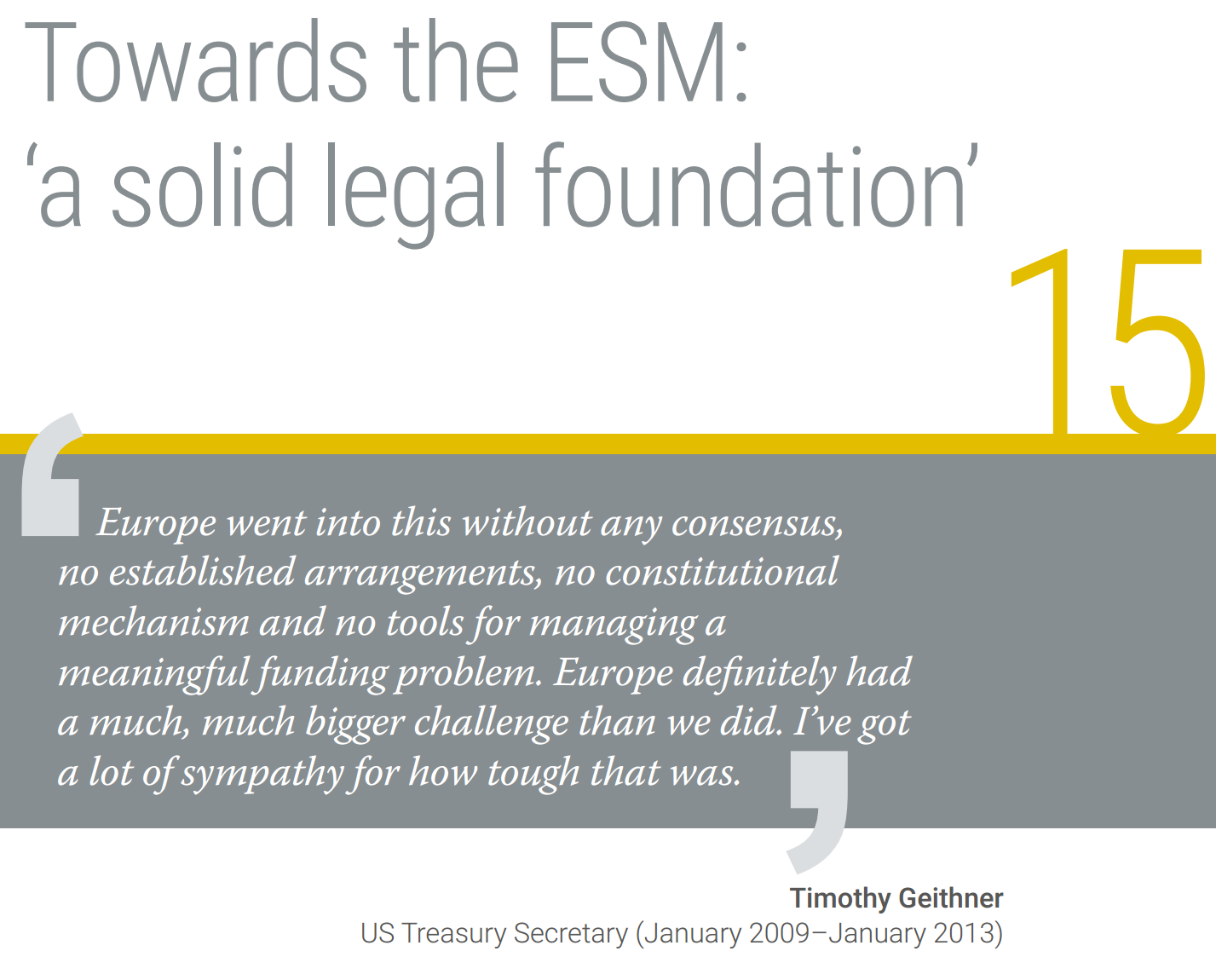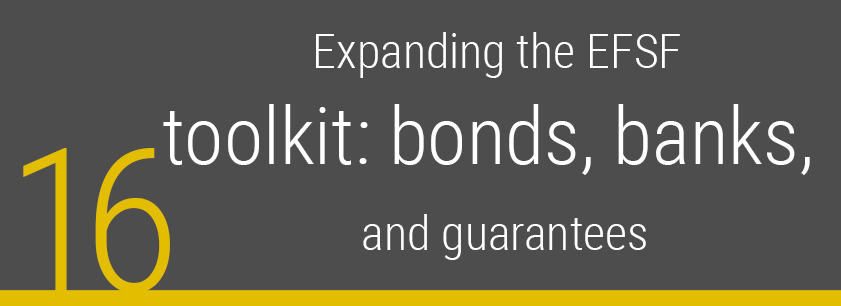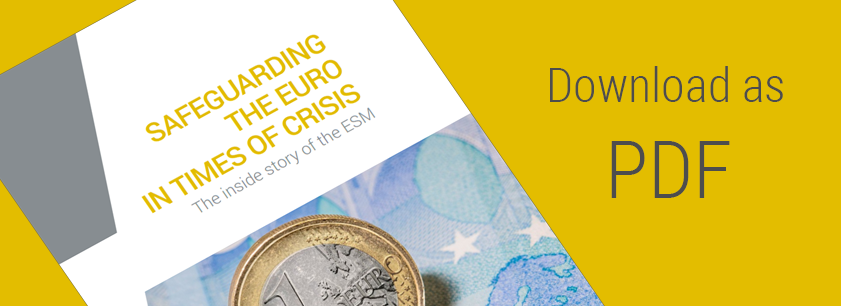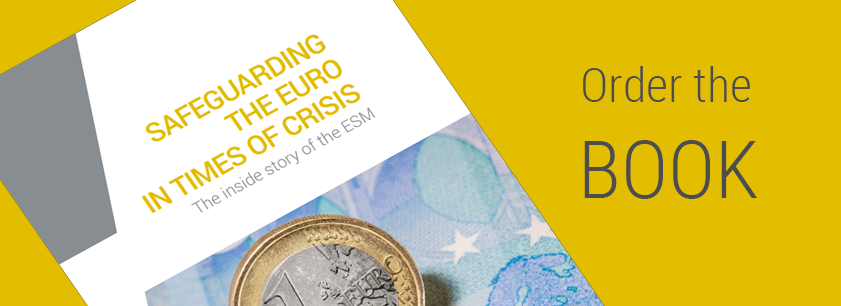15. Towards the ESM: ‘a solid legal foundation’

As the EFSF began operations and financial markets continued to test the euro area, there was a growing awareness that a temporary rescue vehicle would not be enough. The mantra that ‘a crisis is a terrible thing to waste’ became a common refrain, voiced by politicians and commentators alike.
Few saw the hastily set-up EFSF, with its guarantee-based structure, as the model for a new, permanent institution. Its lack of independent financial capacity made its fundraising vulnerable to volatile market moods, and the EU statistical authority classified the guarantees as Member State debt[1], putting a burden on national finances. The temporary fund represented what was politically feasible in May 2010, not what was economically desirable over the longer term.
‘The EFSF was set up as a temporary institution. It would be better to have something with the same mandate and the same instruments, but organise it differently as an international institution and a permanent one,’ said Chief Executive Regling.
High-level impetus for a permanent crisis mechanism had already come in with the Deauville understanding between Chancellor Merkel of Germany and President Sarkozy of France in October 2010. But there would be no repeat of the rushed establishment of the EFSF. For one thing, the immediate crisis seemed to retreat in late summer and early autumn 2010.
More importantly, given the legal challenges filed in Germany against the ad hoc euro area rescue policies, a permanently endowed fund had to first be anchored in EU law.
‘Once the EFSF was established, what was important was to then move to the next step and create something that would be more robust and more credible,’ Malta’s Camilleri said. ‘It was important that we create an institution that was robust for the longer term.’
A discussion started over whether or not to amend the Treaty on the Functioning of the European Union, especially in the light of the Article 125 provision, which makes it illegal for a Member State to ‘assume the commitments’ of other members. Commonly known as the no-bailout clause, Article 125 was intended to dissuade countries from running up excessive debts.
EU leaders endorsed the idea of a permanent fund at an October 2010 summit and addressed the broader legalities in December 2010, when they composed an amendment to Article 136 of the EU Treaty[2]. This text affirmed that a stability mechanism could be established by the Member States ‘if indispensable to safeguard the stability of the euro area as a whole’[3]. It meant that both the ESM and conditions for its use were reflected in primary law, the EU’s founding treaties. Financial aid under the mechanism, the amendment said, would be subject to economic and financial reforms, also known as strict conditionality.
The ESM was thus infused with a hybrid legal character. It was clarified that the permanent firewall was compatible with the EU Treaty, by virtue of the amendment, but set up outside the EU framework as an agreement among euro area governments. Gaspar, a former finance minister of Portugal who now heads the IMF’s fiscal affairs department, said the decision to go the intergovernmental route instead of founding a fully fledged EU institution expedited the set-up.
‘If you had tried to do it inside the European Union machinery involving the creation of a new institution through a treaty change, that would have taken much, much longer,’ Gaspar said.
One outcome of this strategy was tighter control by national governments, said Buti, the European Commission’s director-general for economic and financial affairs. ‘The feeling was also that through an intergovernmental approach, Member States and parliaments had more of a grip on this and a capacity to stop,’ Buti said.
Germany’s former Finance Minister Schäuble said the treaty amendment facilitates the provision of financial aid without violating the no-bailout clause. ‘The newly added article[4] explicitly clarifies that it is permissible for the euro area member states to provide each other with financial assistance, as a last resort to ensure the stability of the currency union and only under strict conditions,’ Schäuble said. ‘These kinds of exceptional situations do not represent a violation of the no-bailout rule. Hence the ESM Treaty is based on a solid legal foundation.’
In the first half of 2011, decisions on the shape of the ESM took place against a fraught political and economic backdrop. Greece’s economy continued to deteriorate, making an additional injection of aid likely, while Ireland and Portugal had embarked on their own programmes.
‘There was a perception, or the understanding, that some countries were just too big for the EFSF capacity and that we needed to find something more robust to handle what would come in the future,’ said Albuquerque, who also served as Portuguese finance minister.
At first, the permanent fund was conceived of as a more smoothly functioning offspring of the EFSF. Its key operational features, sketched out by Eurogroup finance ministers in November 2010[5] and finalised at a European summit on 24 and 25 March 2011[6], resembled the EFSF’s capabilities at the time. The ESM was to be equipped with two instruments – lending to distressed member states based on a full macroeconomic adjustment programme, and primary market bond purchases – with a pricing structure that mimicked the EFSF’s[7].
In that early conception, aid decisions would have been by unanimity and the ESM would have enjoyed preferred creditor status over private sector bondholders, two features that triggered criticism.
What set the ESM apart was the use of paid-in capital instead of the EFSF’s guarantees. Euro area member states would contribute €80 billion upfront[8]. The funds were initially to be transferred in five annual instalments, starting with the ESM’s planned launch in July 2013. Euro area leaders also agreed on an additional €620 billion in ‘callable’ capital to be contributed when requested, giving the ESM a total subscribed capital base of €700 billion.
‘What is interesting, as a footnote to financial history, is that we created a unique mechanism for calling capital,’ said Verwey, a senior Dutch finance ministry official at the start of the crisis who is now with the Commission. ‘It deviates from everything that had been done before with financial institutions. We more or less automated it. From a rating perspective, this provides more security that the capital will indeed be there.’
Those sums would give the ESM a strong position to borrow on the bond markets, enabling the ESM Board of Governors to endow the ESM with a lending capacity of €500 billion, a figure that harked back to euro area pledges at the EFSF’s creation in May 2010.
The idea of a fully capitalised crisis response institution had been aired at the outset of the crisis, but wasn’t ripe politically, the Commission’s Benjamin Angel said. ‘We could not have convinced member states at that time to go for a capital structure, so we needed the EFSF to convince them that we could do a much better job and build in future a much more effective and more operational instrument,’ he said. ‘If we had gone straight to this nice and neat structure that the ESM is, I don’t think we could have managed to get everybody on board.’
Work on the ESM Treaty proceeded in the spring and summer of 2011, with the Commission in charge of the drafting. The lead role fell to Angel, who had been one of the Commission’s point men in shaping the initial crisis response tools. To sketch out the first version of the ESM Treaty, Angel closeted himself in his office for two days to delve into the workings of existing international financial institutions. ‘I printed the statutes of all the IFIs [international financial institutions] I could find, read them and their treaties to see what was behind there: how does it work, what kind of elements do we need to put in?’ Angel said. ‘We needed to start from somewhere.’
The London-based European Bank for Reconstruction and Development, a multilateral development bank, was founded in 1991 and was thus the youngest major international financial institution at the time. It therefore proved to be a relevant template for internal administrative issues such as staffing and accounting, but that was of secondary importance to the governments that would underwrite the ESM.
‘Ministers cared about our capital, how much they had to pay into the ESM because they had to generate the funds, and the treaty. They asked: “What are the voting modalities?’ The governance?” That’s what is important politically,’ Regling said. ‘There were very intense negotiations about the treaty.’
Both solidity and flexibility were called for. The ESM had to be firmly grounded, yet adaptable enough to deal with a crisis at an indeterminate point in the future. It made little sense to include treaty language that would confine the permanent fund to using only the two policy instruments then available to the EFSF. Jansen, the firewall’s first general counsel, recalls that, at the time, discussions were already underway over adding tools such as direct bank recapitalisation. The firewall’s architects were aware others might be needed in future.
‘We knew this possibility and other possibilities, so we included in the treaty Article 19, which said that new instruments can be added by a resolution of the Board of Governors, which means the treaty need not be changed,’ Jansen said.
One question for the ESM Treaty was what kind of ties the permanent fund would have to the IMF. Even the member states that had sought an IMF role in the euro rescue effort were hesitant to write this irrevocably into the ESM Treaty. Nor could the euro area pre-commit the IMF on any policy question. The solution was to require a euro area member state that solicits financial aid to also ‘request’ it from the IMF, without prejudging the outcome.
ESM Treaty drafters had to address concerns in the markets – amplified by the growing speculation in early 2011 that Greece would have trouble repaying its debts – that the permanent fund would be used as a debt-restructuring vehicle to force losses on private sector bondholders. Some investors were critical of a treaty requirement that all euro area member states equip their sovereign bonds with collective action clauses, which set out a predictable mechanism to allow a voluntary agreement on a re-profiling or restructuring in crises, thereby preventing bondholders from refusing to take part.
Some countries had instituted similar clauses already. The treaty stipulated that all ESM Members attach collective action clauses in new bond issuances (with maturities above one year) as of 1 January 2013, grandfathering previously issued debt as per standard practice. Vittorio Grilli, a former Italian finance minister and now a senior executive at J.P. Morgan, said that both the clauses and the exemption for existing bonds served to enhance euro area financial stability. ‘They were very careful that the collective action clauses would not apply to the outstanding debt,’ he said.
The first version of the treaty explicitly gave the ESM a role on debt sustainability management. In cases where debt was deemed sustainable, private investors would be encouraged to maintain their exposure; but, in cases where debt was not deemed to be sustainable, programme countries were required to engage in active negotiations in good faith to secure direct involvement from their non-official creditors in restoring debt sustainability. The first version went as far as saying that the granting of financial assistance would be contingent on the country having a credible plan for restoring debt sustainability and on its demonstrating sufficient commitment to ensure adequate and proportionate private sector involvement. Progress in the implementation of that plan would be monitored under the programme and would be taken into account in the decisions on disbursements.
Given the market jitters around requiring haircuts on sovereign debt, this was missing from the second and final ESM Treaty that would be adopted in 2012, other than a mention in the opening recitals.
Similar sensitivities were in play over asserting an ESM claim to preferred creditor status in the manner of the IMF. Such status was intended to protect the ESM as a lender of last resort, given that it is willing to lend to sovereigns when no one else does, in the case of a debt restructuring. This was not an issue for the EFSF, which ranks on an equal footing with other creditors. For the ESM, it was not clear how markets would manage the transition to the new framework, as other creditors had not been expecting their claims to become lower priority in the euro area. It was eventually decided politically that the firewall should waive preferred creditor status for Spain’s aid programme.
With respect to the ESM’s preferred creditor status, some nations made the point that taxpayers would benefit from the added protection, since, as a lender of last resort, the ESM would lend to a country only when all other investors are out. The counterargument was that it could scare off the same bond investors that the ESM was meant to put at ease. What is more, while the IMF’s status atop the lending hierarchy has been recognised thanks to its global membership, there was concern that investors outside Europe might contest the ‘preferred’ claim of the ESM as a purely European entity.
‘Preferred creditor status is good for you as preferred creditor, but it’s not good for the other creditors,’ said ESM Risk Officer den Ruijter. ‘It was quite a tricky issue and there were strongly divergent views among the countries.’
The solution reached in June 2011 was to rank the permanent fund as a preferred creditor just below the IMF, a status that did not apply to EFSF lending to the three countries then receiving rescue loans[9]. A year later, the same held true for Spain’s bank recapitalisation programme, which was transferred to the ESM from the EFSF ‘without gaining seniority status’ in order to reassure holders of Spanish bonds that their investments would not be suddenly demoted in the creditor hierarchy[10].
Wealth divergence across the euro area led to an adjustment of the national capital contributions. Central European countries such as Slovakia, with GDP per capita below the euro area average, argued that it was too burdensome for them to pay into the ESM at the same rate – based on each country’s shareholding in the ECB – as the more advanced economies.
Den Ruijter, who was at the time with the Dutch finance ministry, worked out a mechanism to benefit new ESM Members with GDP per capita below 75% of the EU average. This adjustment applies to the initial paid-in capital plus any future capital calls or increases in the overall capital stock. It is spelled out in Article 42 of the ESM Treaty, with eligibility restricted to the first 12 years of a country’s euro membership. Slovakia, for example, will benefit until 2020, whereas Lithuania, which joined in 2015, can benefit from the mechanism until the end of 2026. Malta, Estonia, and Latvia, are all also currently benefiting. Slovenia’s temporary adjustment ended on 1 January 2019.
‘The correction is only temporary because we assume that over time they’ll catch up with the rest of the euro area,’ den Ruijter said.
On 11 July 2011, finance ministers from the then 17 euro countries signed the first version of the ESM Treaty[11], an act that would normally be the prelude to ratification by the Member States. But by then, forces were at work – in Greece, in the euro area more broadly, and in financial markets – that would lead the euro area to redo the treaty, revise its crisis-fighting strategy, and retool its rescue funds.
Continue reading
[1] Eurostat (2011), ‘New decision of Eurostat on deficit and debt: The statistical recording of operations undertaken by the European Financial Stability Facility’, Press release, 27 January 2011. https://ec.europa.eu/eurostat/documents/2995521/5034386/2-27012011-AP-EN.PDF/25064294-4eae-4b50-a447-60165ca9718d?version=1.0
[2] Conclusion of the European Council meeting (2010), CO EUR 21, CONCL 5, 17 December 2010. http://data.consilium.europa.eu/doc/document/ST-30-2010-INIT/en/pdf; All euro member states ratified the amendment in time for the ESM’s introduction in October 2012, but the amendment didn’t enter into force until 1 May 2013 following the final ratification by the Czech Republic. See. European Parliament (2013), Article 136 TFEU, ESM, Fiscal Stability Treaty, Ratification requirements and present situation in the Member States, 11 June 2013. http://www.europarl.europa.eu/meetdocs/2009_2014/documents/afco/dv/2013-06-12_pe462455-v16_/2013-06-12_pe462455-v16_en.pdf
[3] EU (2011), European Council decision of 25 March 2011 amending Article 136 of the Treaty on the Functioning of the European Union with regard to a stability mechanism for Member States whose currency is the euro, OJ L91/1, 6 April 2011. http://eur-lex.europa.eu/legal-content/EN/TXT/PDF/?uri=CELEX:32011D0199&from=EN
[4] EU (2012), Consolidated version of the Treaty on the Functioning of the European Union, OJ C326/47, 26 October 2012, Article 136(3). https://eur-lex.europa.eu/legal-content/EN/TXT/PDF/?uri=CELEX:12012E/TXT&from=EN
[5] Statement by the Eurogroup, 28 November 2010. http://www.consilium.europa.eu/uedocs/cms_data/docs/pressdata/en/ecofin/118050.pdf
[6] European Council 24/25 March 2011 Conclusions, CO EUR 6 CONCL 3, Annex II, 24 and 25 March 2011. http://register.consilium.europa.eu/doc/srv?l=EN&f=ST%2010%202011%20INIT
[7] European Council (2012), ‘Treaty establishing the European Stability Mechanism’, Factsheet, 2 February 2012. http://www.consilium.europa.eu/uedocs/cms_data/docs/pressdata/en/ecofin/127788.pdf
[8] European Council 24/25 March 2011 Conclusions (2011), CO EUR 6 CONCL 3, 24 and 25 March 2011. Annex II. http://register.consilium.europa.eu/doc/srv?l=EN&f=ST%2010%202011%20INIT
[9] Reuters (2011), ‘ESM not preferred creditor for three bailout states’, 20 June 2011. https://www.reuters.com/article/eurozone-esm-status/esm-not-preferred-creditor-for-three-bailout-states-idUSLDE75J1OG20110620
[10] Statement by the Eurogroup, 20 July 2012. http://www.consilium.europa.eu/uedocs/cms_data/docs/pressdata/en/ecofin/131914.pdf
[11] Treaty establishing the European Stability Mechanism, 11 July 2011, Luxembourg. https://www.cvce.eu/en/obj/treaty_establishing_the_european_stability_mechanism_11_july_2011-en-cb18477d-69e4-4645-81a9-3070e02d245a.html


